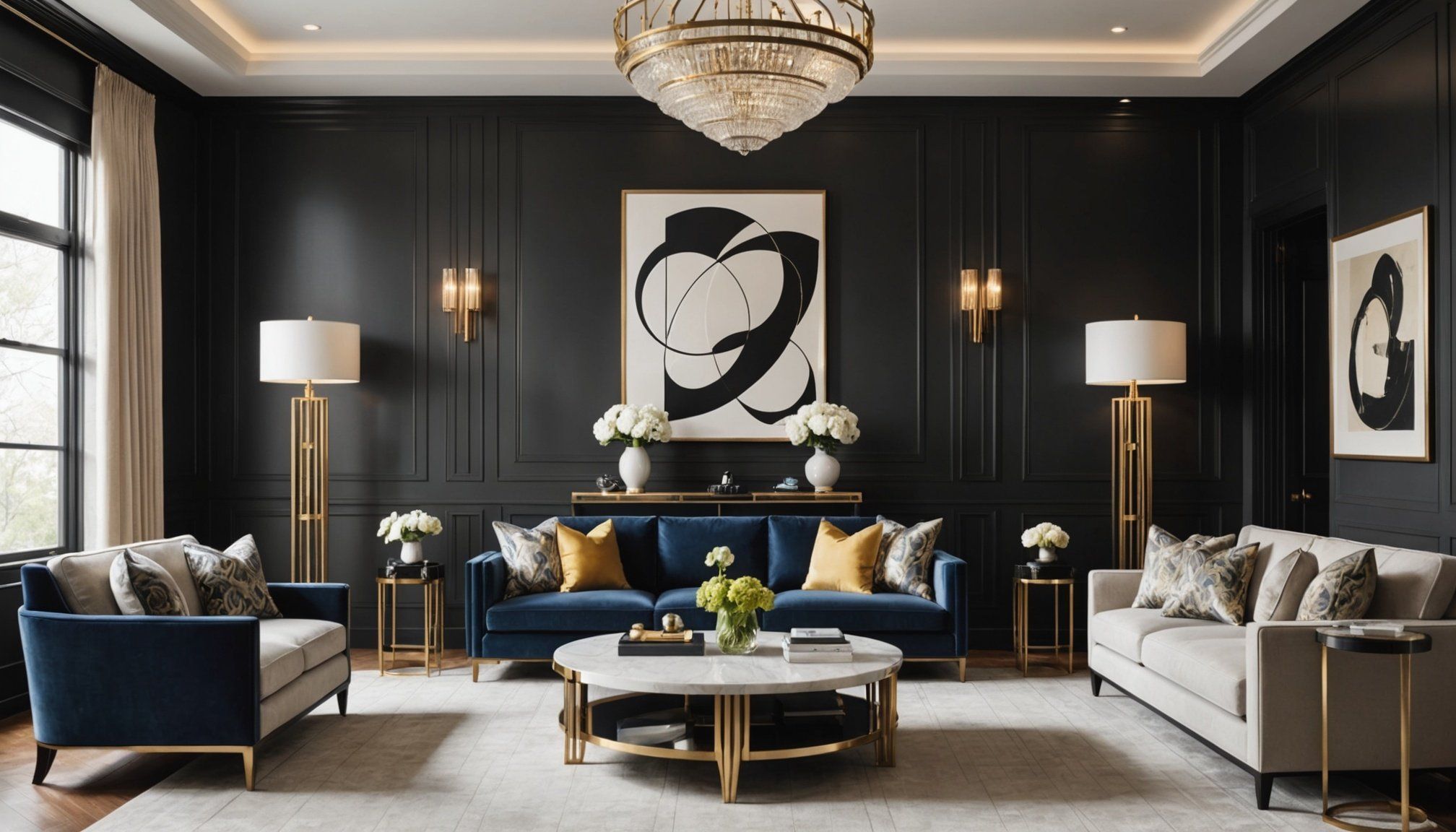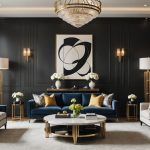Color Palettes and Materials in Art Deco
Art Deco struck the world with its bold use of color and luxurious materials. At the heart of Art Deco colors are dramatic color combinations. Designers often choose rich tones such as deep blue and gold, setting a backdrop of sophistication. Scarlet, emerald green, and royal purple contribute flashes of opulence.
Materials play a crucial role in embodying the elegance of the Art Deco style. Mirrored and polished surfaces are predominant, with chrome and stainless steel adding modern flair. Dark woods, including ebony and mahogany, bring warmth and depth. Luxurious materials like leather and exotic skins, such as zebra and alligator, make an appearance in high-end finishes.
Also to discover : Unleash stronger ankles: the top 3 essential exercises for high heel lovers
Tips for selecting a cohesive Art Deco palette include focusing on contrasts and balance. Pair dark hues with lighter shades to allow light reflection and keep spaces from feeling heavy. Opt for high-gloss finishes to accentuate the interplay of light.
Choosing the right materials is pivotal to achieving the authentic Art Deco look. Combine metal accents with sumptuous fabrics for a balance of glamour and comfort. Your choices set the stage for creating visually striking and harmonious interiors that resonate with the decadence of the Art Deco era.
Also read : Revamp Your Beauty Rituals: Adopt These Green Practices for a Sustainable Glow
Understanding Art Deco Style
Art Deco style is renowned for its sleek forms and opulent craftsmanship. Emerging in the early 20th century, it thrived during the Roaring Twenties and the Jazz Age, epitomising glamour and sophistication. Its historical significance lies in its response to industrialisation, celebrating technological advances with symmetry, geometry, and rich materials.
Design elements central to Art Deco include its pronounced use of geometric shapes, such as zigzags, chevrons, and stepped forms. These motifs are frequently seen in architecture, jewellery, and interiors, creating an eye-catching visual impact. The style often incorporates exotic influences, drawing inspiration from Egyptian, Aztec, and Asian cultures, adding a layer of mystique and diversity.
As Art Deco evolved, it laid the foundation for modern and contemporary design. It continues to influence today’s design landscape with its enduring elegance and streamlined aesthetics. Incorporating Art Deco elements can introduce a distinctive sense of style and heritage, creating interiors that are both visually striking and timeless. By understanding these design fundamentals and historical context, you can effectively integrate Art Deco motifs and elements into modern settings, achieving a seamless blend of past and present.
Furniture Styles that Define Art Deco
Art Deco furniture is known for its distinctive craftsmanship and streamlined elegance. Emphasising geometric shapes and sculptural forms, these pieces often feature rich materials like exotic woods, chrome, and glass. Furniture during the Art Deco period exemplifies both elegance and functionality, with every piece designed to reflect luxury.
Iconic furniture pieces associated with Art Deco include the club chair, which embraces comfort with its deep seats and strong form. Another staple is the zigzag table, renowned for its angular lines and bold presence. A standout in many Art Deco interiors is the armoire, often embellished with inlays or marquetry, showcasing intricate artistry and high-end finishes.
To effectively integrate Art Deco furniture into modern spaces, consider selectively choosing statement pieces that serve as focal points. Mix these vintage elements with contemporary pieces to create a juxtaposition that retains Art Deco’s luxurious appeal while maintaining a modern edge. By balancing the old and new, you can achieve a look that is cohesive and stylish, perfectly capturing the essence of both eras without overwhelming your decor.
Incorporating Decorative Accessories
Decorative accessories play a pivotal role in enhancing the Art Deco aesthetic, bringing an added layer of elegance and detail to any space. Essential Art Deco accessories often embody geometric patterns, luxurious materials, and bold contrasts, reflecting the era’s opulence and glamour.
To successfully integrate Art Deco accessories into your interior without overwhelming it, focus on balance and restraint. Mirrors with intricate geometric frames, shimmering metallic sculptures, and bold vases in jewel tones can serve as focal points. These elements should echo the larger themes in the room, maintaining a cohesive aesthetic.
When selecting pieces, consider those that capture the style’s essence through design and material. A circular clock with radiating gold lines, for example, can add both functionality and flair. Exotic accents such as a zebra print rug or lacquered picture frames can also elevate your decor without saturating the space.
To complement the overall design, position these accessories thoughtfully. Place symmetrical objects on either side of a central fixture, or use clusters of varied items to add depth and interest. Through careful selection and placement, decorative Art Deco elements can artfully amplify the luxurious sense of the era in your modern spaces.
Achieving Modern Harmony with Art Deco
Blending modern décor with Art Deco elements creates a unique and sophisticated aesthetic. The key to achieving this balance is understanding how the bold, geometric patterns of Art Deco can complement rather than overpower modern design. When integrating these styles, focus on using statement Art Deco pieces that echo the clean lines and simplicity of contemporary design.
Start by selecting a few signature Art Deco elements—such as an iconic zigzag pattern or a bold, sculptural piece of furniture—that can stand as focal points in your space. Maintain balance by juxtaposing these with minimalistic elements, creating harmony without clutter.
Design balance can be achieved through the thoughtful combination of textures and materials. For instance, pair a sleek, chrome Art Deco lamp with a soft, modern sofa to juxtapose glamour and simplicity effectively.
A successful Art Deco and modern blend often involves neutral colour palettes enhanced by richly coloured decorative accents, such as a striking scarlet cushion or a vibrant emerald vase. This cautious use of colour keeps the overall design cohesive and inviting.
By mastering this blend, your space can capture the timeless elegance of Art Deco while embracing modern trends.
Visual Inspirations and Case Studies
Art Deco design offers a wealth of visual inspiration, often showcased in both historical and modern contexts. Examining Art Deco design examples, for instance, reveals how iconic motifs and colour schemes are effectively integrated into spaces. These examples highlight the striking interplay of geometric patterns and rich materials that define the style.
Case studies provide deeper insights into the successful application of Art Deco principles in residences. A notable example might feature a home where symmetry and bold colour combinations create an inviting yet sophisticated environment. In such a setting, the graceful arches and ornate details could pay homage to Art Deco’s grandeur while complementing contemporary elements.
Drawing inspiration from both historical and modern Art Deco designs, one can learn the art of blending these features. Study the use of intricate inlays in furniture or the placement of opulent light fixtures as focal points. These elements enhance the luxurious ambiance characteristic of the era.
By exploring visual inspirations and case studies, you can better understand how to incorporate Art Deco motifs into your own space, weaving a narrative that celebrates past elegance and modern innovation.











